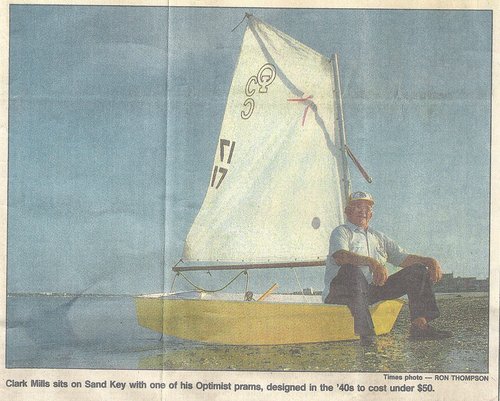FBYC History....
Jere Dennison
I confess that your Historian had been completely ignorant of the fascinating and humble origins of the ubiquitous Optimist Pram (a/k/a the Opti). The Opti is FBYCs primary junior trainer and numbers in the hundreds of thousands around the world. I dare say that most internationally renowned sailors today first learned to sail in the little Opti.
Thanks to member Barbara Rennie of Heathsville, the scales have fallen from my eyes. Recently I received a note from her, accompanied by a 1990 newspaper clipping from the St. Petersburg Times discovered in one of her Mothers books. Barbara grew up in Dunedin, Florida where the first builder/designer, Clark Mills, lived. If you were not aware that the Opti was originally conceived as a nautical version of a Soap Box Derby racer and was named for the Clearwater Optimist Club that commissioned the boat in 1947, then you should find the following (slightly abbreviated) reprinted article highly informative and entertaining.
Boat Builder Put Thousands on Water
By Teresa Burney
St. Petersburg Times Staff Writer
July 9, 1990
Clearwater - Clark Mills thinks its funny that his most famous sailboat design looks a bit like a floating horse. All that high-tech stuff has people wore out. They want to sail in a horse trough now, the 76-year-old retired boat builder said, chuckling.

Mills had no idea more than 40 years ago when he started sketching a design for a childs sailboat that one day his blunt-nosed creation would be floating by the thousands in the waters of the world. Thousands of people have learned to sail in the little boat.
It all started because Clearwater has no hills and the Optimist Club wasn't having much luck with its Soap Box Derby racing cars. Then one day, sometime around 1947, Clifford Anderson McKay made a speech at the club about juvenile delinquency. He proposed another solution to keep Clearwaters youngsters out of trouble a kind of Soap Box Derby on the water, recalled Ann Garris, McKays daughter.
He took his idea to Mills, a well-known boat builder in Clearwater. He asked Mills to design a small sailboat for youngsters that would be light, stable and simple. They wanted something that a child and father could build in the garage.
The catch was it had to cost less than $50. Everything was over $50, even back then, Mills said. So he started drawing and calculating. He drew some little skiffs with pointy noses, but every time the cost of building one was higher than $50. Finally he cut off the pointy bow and managed to cut the cost down to just under $50.
Mills built his creation in his tin-roofed shop in Dunedin and took it out to the dock at the end of Haven Street. He sailed around in it for about five minutes, then turned the tiller over to McKays son, Clifford Anderson McKay Jr.
McKay Jr., who was about 12 then, remembers the day. There was a little breeze blowing, McKay said. It was delightful.
Mills gave the Optimist Club the boat plans and McKay Sr. started selling the idea of fleets of the little boats for youngster to other Optimist Clubs. He went all over the state selling others on the idea of having a pram fleet, Mrs. Garris said. Now the boat can be found all over the world, not only in Optimist-sponsored programs. Even adults sail them.
Famous sailors, such as Allison Jolly, a local woman who won an Olympic gold medal in Seoul in 1988 said she learned to sail in an Optimist pram in St. Petersburg. A Soviet sailor who recently stopped in Pinellas County during a race around the world said he learned how to sail on an Optimist pram.
Maybe not, but Mills is certainly proud of the little boat, not because he thinks its such a good design, but because it has given so many children joy. They have such a good time that I am pretty happy that I had a part in it, Mills said. Just cause they look stupid dont mean nothin. It sails like a dream.